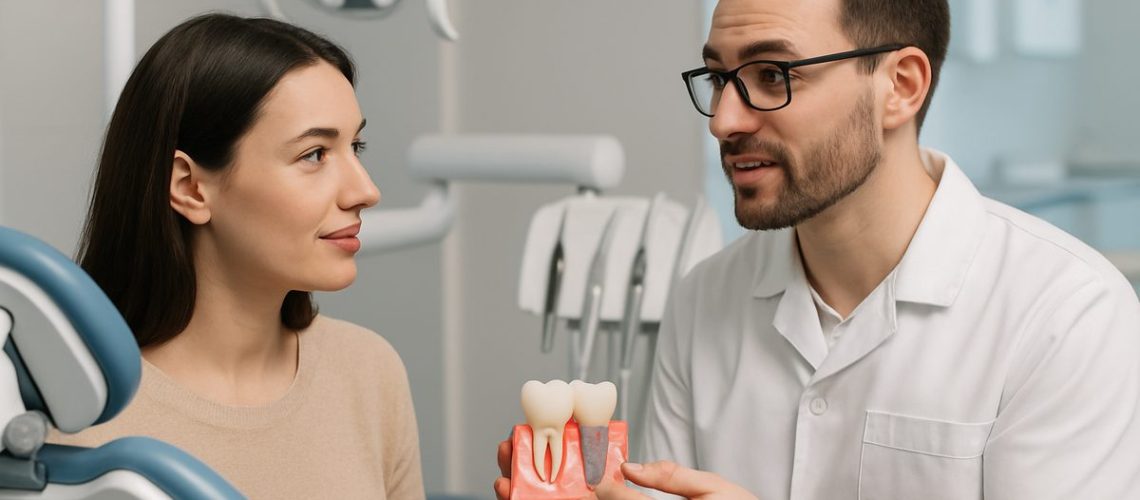Preparing for dental implant can feel overwhelming, but knowing what to expect before, during, and after surgery helps you feel calm and ready. This guide walks you through each step in plain language, explains why certain checks and tools are used, and gives practical tips to reduce risk and speed recovery. Most patients follow these steps and heal without problems.
Before surgery: initial steps
Consultation and digital planning
Your first visit includes a medical history, an oral exam, and 3D CBCT imaging to map your jaw, nerves, and sinuses. Digital scans and virtual planning let the surgeon choose the best implant position ahead of time. This makes surgery safer and more predictable and often shortens time in the chair.
Medical clearance and medication review
Bring a list of all medicines and health issues. Your surgeon may need clearance if you take blood thinners or have uncontrolled diabetes. Sometimes antibiotics or changes in medication are recommended. Being honest about your health helps prevent complications.
Pre-op instructions: eating, alcohol, and smoking
If you have IV sedation, you’ll likely be asked to fast for several hours. Avoid alcohol for at least 24 hours before surgery. Stop smoking if possible — smoking slows healing and raises infection risk. Prepare a quiet recovery spot at home with soft foods, ice packs, and medications ready.
What to expect on the day of surgery
Arrival and sedation options
You’ll check in, sign forms, and meet the team. Options include local anesthesia with nitrous or IV sedation for deeper sleep. Under sedation you may not remember the procedure. The team monitors your vitals the whole time for safety.
The implant placement process
The surgeon makes a small incision, places the implant into the jawbone, and may use bone grafting or PRF (from your blood) if needed. In some cases a temporary crown or bridge is attached the same day. Most steps are quick thanks to digital planning and guides.
Immediate post-op instructions
Expect some bleeding, swelling, and mild pain. Bite gently on gauze to control bleeding, use prescribed pain medicine or over-the-counter options, and apply cold packs for the first 24 hours. Stick to soft foods and avoid straws for a few days.
Recovery timeline and practical tips
First 48 hours
Pain and swelling usually peak during the first 48 hours. Rest, ice, and take medications as directed. Many sutures dissolve on their own; others are removed at a follow-up.
First week to month
Swelling and soreness drop over the first week. Gradually add firmer foods as comfort allows. Keep the area clean with gentle rinses and good brushing nearby. Most people return to light work within a few days to a week.
Long-term healing and prosthetic steps
Osseointegration (bone bonding to the implant) takes several months. You’ll return for follow-ups and final impressions. The permanent crown or bridge is placed once healing is complete.
Common risks, warning signs, and FAQs
Minor issues can include temporary numbness, dry socket (after extractions), or mild infection. Contact your surgeon urgently for heavy bleeding, fever, severe uncontrolled pain, or lasting numbness. FAQs: How long until I can eat normally? (Usually weeks to months.) Will it hurt? (Discomfort is normal but manageable.) Can implants fail? (Rare with proper care.)
Costs, insurance, and financing options
Costs vary by number of implants, grafting, and sedation. Dental insurance may cover parts but often limits implants. Many practices offer financing, payment plans, or third-party lenders to spread cost.
About Texas Center for Oral Surgery & Dental Implants
Texas Center is a family-owned specialist practice serving the Dallas–Fort Worth area with board-certified oral and maxillofacial surgeons. The Center uses in-house digital planning, CBCT imaging, PRF, and same-day provisional options to improve predictability and recovery.
To book a consultation, bring ID, insurance info, and a list of medications. Clear preparing for dental implant — following pre-op rules and bringing honest health info — leads to smoother surgery and a faster recovery.

